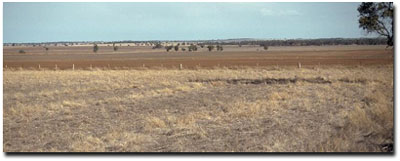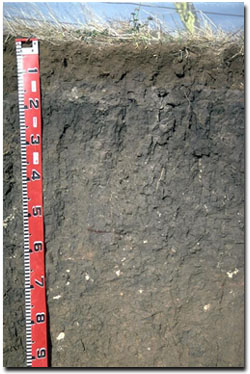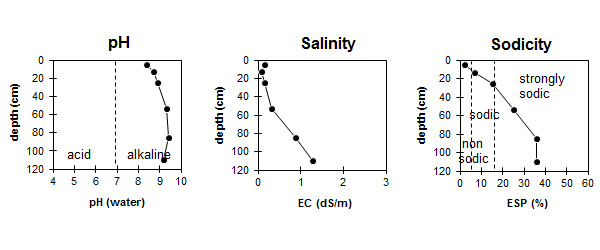LS9
Location: Yanac
Australian Soil Classification: Vertic (and Calcic), Mesonatric, Grey SODOSOL
Northcote Factual Key: Dy 4.33
Great Soil Group: solonetz
General Landscape Description: Midslope (western side) of a Gently Undulating Rise. Generally the slopes average 2-3%.
Native Vegetation: Supports Yellow Gum (Eucalyptus leucoxylon), Buloke and Grey Box (E. microcarpa) when undisturbed.
 LS9 Landscape |
Soil Profile Morphology:
Surface Soil
| A1 | 0-10 cm | Dark brown (10YR3/3); heavy sandy clay loam; moderate medium blocky structure; weak consistence dry; pH 8.4: |  LS9 Profile |
| A2 | 10-15 cm | Dark greyish brown (10YR4/2) sporadically bleached; fine sandy clay loam; strong consistence dry; pH 8.7; sharp and smooth change to: | |
| Subsoil | |||
| B21 | 15-35 cm | Dark greyish brown (10YR4/2); heavy clay; strong medium prismatic, parting to strong coarse blocky structure; very strong consistence moist; pH 8.9; clear and wavy boundary change to: | |
| B22 | 35-70 cm | Dark grey (10YR4/1); heavy clay; moderate prismatic structure; contains few (2-5%) soft calcareous segregations; pH 9.3; gradual change to: | |
| B23 | 70-100 cm | Yellowish brown (10YR5/4); heavy clay; pH 9.4: | |
| B24 | 100+ cm | Light yellowish brown (10YR6/4); heavy clay; strong lenticular structure; very firm consistence moist; pH 9.2. | |
Key Profile Features:
- Texture contrast between surface (A) horizons and heavy clay subsoil (B21) horizon.
- Vertic properties (ie. lenticular structure) in deeper subsoil.
Soil Profile Characteristics:
| - | pH | Salinity | ||
Surface (A1 horizon) | Moderately Alkaline | Very low | Non-Sodic | None |
Subsoil (B21 horizon) | Strongly Alkaline | Very low | Strongly Sodic | Strong |
Deeper Subsoil (at 1 metre) | Very Strongly Alkaline | High | Strongly Sodic | Moderate-Strong |

| The surface soil is moderately alkaline. The subsoil is strongly alkaline becoming very strongly alkaline with depth. | The salinity rating is very low in the surface and upper subsoil becoming high with depth. | The surface is non-sodic. The subsoil is strongly sodic. |
Chemical and Physical Analysis:
Horizon | Horizon Depth (cm) | pH (water) | pH (CaCl2) | EC dS/m | Sodium Chloride % | Exchangeable Cations | |||
Ca | Mg | K | Na | ||||||
meq/100g | |||||||||
A1 | 0-10 | 8.4 | 7.7 | 0.15 | 16.4 | 3.3 | 1 | 0.4 | |
A2 | 10-15 | 8.7 | 7.6 | 0.08 | 10.3 | 2.6 | 0.3 | 1 | |
B21 | 15-35 | 8.9 | 7.6 | 0.14 | 16.5 | 7 | 0.5 | 4.2 | |
B22 | 35-70 | 9.3 | 8.2 | 0.31 | 12 | 9.4 | 0.6 | 7.3 | |
B23 | 70-100 | 9.4 | 8.7 | 0.88 | 0.1 | 8.4 | 9.2 | 0.9 | 10 |
B24 | 100+ | 9.2 | 8.5 | 1.28 | 0.19 | 9.8 | 10.4 | 1 | 11.7 |
Horizon | Horizon Depth (cm) | Total Nitrogen % | Oxidisable Organic Carbon % | Field Capacity pF2.5 | Wilting Point pF4.2 | Coarse Sand (0.2-2.0 mm) % | Fine Sand (0.02-0.2 mm) % | Silt (0.002-0.02 mm) % | Clay (<0.002 mm) % |
A1 | 0-10 | <0.05 | 1.4 | 25.9 | 13.1 | 27 | 27 | 7 | 33 |
A2 | 10-15 | <0.05 | 0.9 | 17.2 | 6.7 | ||||
B21 | 15-35 | <0.05 | 0.7 | 35.1 | 17.4 | ||||
B22 | 35-70 | ||||||||
B23 | 70-100 | ||||||||
B24 | 100+ |
Management Considerations:
Surface (A) Horizon
- The surface soil aggregates do not disperse but may slake if organic matter levels are low.
- The surface horizon has a moderate inherent fertility (based on the sum of the basic exchangeable cations) and total nitrogen levels appear to be low. Organic carbon levels are reasonable but can be improved by adopting practices such as residue retention, minimum tillage and including pasture rotations if cropping occurs.
- The subsurface (A2) horizon appears to be developing into a cultivation pan layer, which may restrict water and root movement. This horizon disperses strongly after remoulding which indicates that disturbance to it (eg. cultivation) whilst in a moist to wet condition is likely to result in structural degradation (such as exacerbated hardpan development). Deep ripping with gypsum application has been advocated by some researchers as an ameliorative technique for sodic subsoils. Such treatment may have a beneficial effect on the subsurface (A2) horizon but should not be carried out when the soil is wetter than the plastic limit. A test strip could be used to assess likely benefits.
- The strongly sodic subsoil disperses strongly and will result in restricted water and root movement in the subsoil. The sporadically bleached A2 horizon above indicates that movement of water is being restricted and that periodic waterlogging occurs. Roots appear to be moving mainly between ped faces in the subsoil.
- The high levels of exchangeable sodium in the subsoil may also result in nutrient imbalances and have a toxic effect on some plants.
- The strongly alkaline subsoil indicates that some nutrients (eg. iron, manganese, copper and zinc) may be poorly available to plants.
- The level of soluble salts is likely to affect plant growth from about 70 cm depth down the profile.


